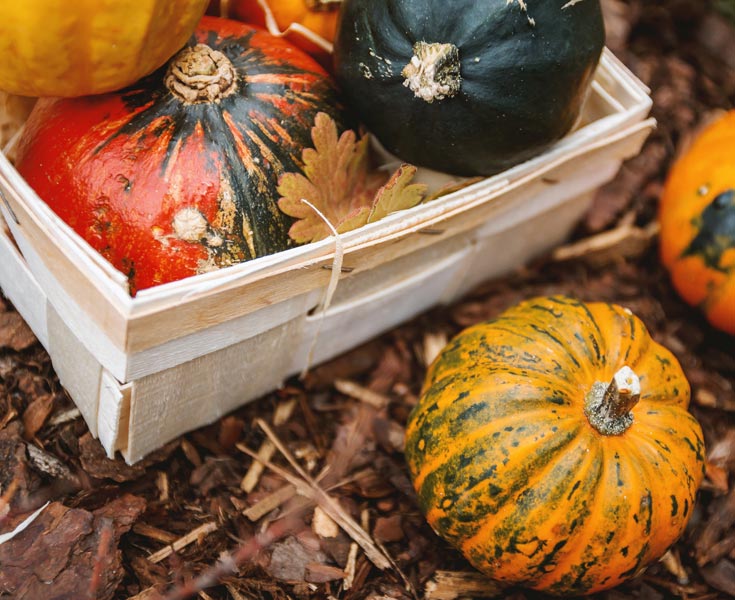Eating in-season produce supports local agriculture and helps keep food costs lower. And during the fall harvest season it’s also incredibly yummy. Here’s a guide to some of the nutritional powerhouses that are in season, and some easy and simple ideas for how to prepare them.
Squash
Squash provides vitamins A and C, folate, omega 3 fatty acids, and loads of fiber. It’s also one of the sweeter and more versatile vegetables.
Spaghetti squash
Spaghetti squash is a fun squash to play with. Pierce the outer skin several times with a sharp knife and microwave on high for 5 minutes; turn and microwave another 4, and then (if necessary) microwave a minute at a time, until soft when you press it. Then carefully (due to heat and steam) cut the squash in half lengthwise and scrape out the squash ‘noodles’ with a fork.
You can treat these just like pasta and top with your favourite tomato-based sauce.
Alternatively, you can make a spaghetti squash bake. Follow the instructions above but then pre-heat oven to 350 degrees Fahrenheit (175 degrees Celsius). While the oven pre-heating,toss squash noodles with:
• 1 can (796 ml) diced tomatoes
• 1 tablespoon olive oil
• 2 teaspoons Italian seasoning mix (or 1 teaspoon dried oregano, 1 teaspoon dried basil and salt and pepper to taste).
Place in a greased casserole dish.
Top with 1 cup grated low-fat cheese or 1 cup whole wheat breadcrumbs, or combination thereof.
Bake uncovered for 20-30 minutes. This is excellent served with pork chops or grilled chicken breast.
Butternut Squash
Butternut squash is one of the sweetest squashes. Its flavour makes it a favourite to roast, simply dressed with olive oil and a bit of salt and pepper. It also makes great soup. Here’s one quick and easy soup recipe to try:
• 1 medium butternut squash, peeled, seeded, and diced (tip: to make squash easier to peel, pierce with a knife and microwave on high for 2-3 minutes. Allow to cool and then proceed.)
• 1 onion, diced
• 2 cans (284 ml each) or one box (500 ml) low-sodium chicken broth
• 1 cup water
• 1/2 to 1 tablespoon freshly grated ginger (optional; you can substitute with 1 teaspoon marjoram, or 1/2 teaspoon nutmeg for different flavours)
• 1 can (370 ml) fat-free evaporated milk
• 1 tablespoon olive oil
• Salt and pepper to taste
Sauté onion in olive oil until soft and golden; add in cubed squash. Cover with chicken broth and water. Add ginger and bring to a boil. Reduce and simmer 40 min, or until squash is soft when prodded with a fork. Puree with a hand blender right in saucepan (as long as it is not non-stick), or in blender until smooth. Stir in evaporated milk and warm until heated through. Season to taste. Serve with fresh whole-grain bread or a spinach salad.

Cauliflower
Cauliflower is going through a renaissance as a vegetable of choice. This vitamin C and vitamin K bearing powerhouse also contains folate. Roasting it brings out its nutty flavour.
To roast, preheat oven to 400 degrees Fahrenheit (200 degrees Celsius). Cut florets off two heads of cauliflower. Place florets in 13″ x 9″ baking dish with aluminum foil and pan, stem side down. Pour 3/4 cup water in bottom of pan. Drizzle 2 tablespoons olive oil over cauliflower; sprinkle with 1 teaspoon dried oregano and salt and pepper to taste. Cover dish with aluminum foil; bake for 30 min or until stems are soft.
Sweet potato
With the peels, you can’t really pack more vitamin A into a vegetable than sweet potato contains – twice the daily recommended minimum. It also contains vitamins C and B6 and is a source of potassium. Roast instead of regular potato, or alongside it. This recipe for maple-mashed sweet potato doesn’t include the peels but is still vitamin-packed:
• 5 medium sweet potatoes, peeled and diced
• 2 tablespoons maple syrup
• 1/8 teaspoon nutmeg
• 1 tablespoon butter or margarine
Place sweet potato in saucepan and cover with water. Bring to a boil; then simmer for 20 min or until potato is soft when prodded with a fork. Drain; return sweet potato to saucepan. Mash with remaining ingredients and season with salt and pepper to taste.
Pomegranate
Pomegranate juice is a trendy miracle cure. Although we won’t claim they prevent all disease, pomegranates do contain high levels of cancer-fighting antioxidants, along with vitamins A and C. The juice is certainly expensive, though, and during pomegranate season there’s no need to avoid the full fruit, which includes more fiber.
Fun pomegranate fact: each pomegranate contains about 840 seeds, and it is surrounding these seeds that you find the flesh and juice.
To peel a pomegranate, cut off the crown and scoop out some of the centre core without disturbing the seeds. Then score the outer rind in quarters. Insert your thumbs in the middle and pull back. Once you peel away the papery coating, the seeds can pop out.
These seeds can be eaten as is, or used as part of a salad — a spinach salad with red onion and commercial poppy seed dressing topped with toasted walnuts is particularly tasty.


